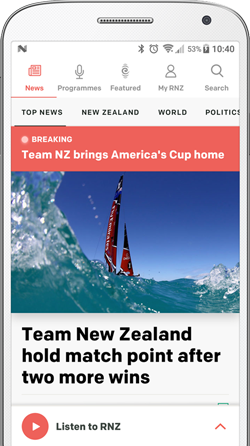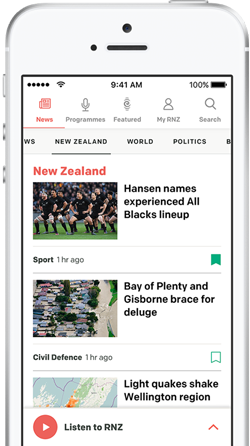
Doctors Art Nahill, left, and Glenn Colquhoun are taking their “vanbulance” on a Hīkoi for Health to highlight the decline of New Zealand’s public health system. Photo: RNZ/Peter de Graaf
Two doctors are hoping to turn their anger and frustration over the decline of New Zealand's public health system into a bottom-up blueprint for change.
Doctors Art Nahill and Glenn Colquhoun are on a two-week "Hīkoi for Health" the length of the North Island, talking to as many people as possible about their experiences of the health system and their ideas of how it could be fixed.
With both men known for their poetry, they also hope to harness their anger and turn it into art.
The second-hand van they are travelling in, dubbed the "vanbulance", is itself a mobile work of protest art, decorated by Dunedin painter Nigel Brown.
Nahill said he and Colquhoun had become increasingly alarmed about the deterioration of the public health system.
"It's just got to a point where we've become more and more angry and more and more frustrated, and all of our colleagues and our patients are angry and frustrated, and we wanted to try to do something to turn that anger and frustration into a positive movement," he said.
"In some ways, we feel like we're doing the government's job, because we're going out trying to find out what a good health system would look like for people on the ground, and then we're going to try to put it together and present it to the government so they have a blueprint for moving forward."
The pair's Hīkoi for Health started in Kaitāia on Saturday morning, stopped in Kerikeri that afternoon and in Whangārei on Sunday, spent Monday in Auckland, and heads to Hamilton on Tuesday.
After stops in another seven towns and cities they aim to arrive at Parliament on 8 May to present a preliminary report of their findings.
A more polished report would follow later, Nahill said.
As well as the interviews they were collecting en route, people were invited to make submissions via the hīkoi's website.
Nahill said more than 100 suggestions for a better health system had been received even before they left Kaitāia.
The US-trained doctor said when he arrived in New Zealand 20 years ago, he could say "hand on heart" New Zealand's health system was better than the one he had left behind.
"But over the past couple of decades, hospitals have become busier and busier. Emergency rooms are overrun. We've shifted from being carers to being assembly line workers, and our goal is to just push people through the system as quickly as possible.
"There's a lot of moral injury that health care providers suffer, because we know we're not providing the care that people need and deserve," he said.
"It's just reached a point where people are burning out and people are leaving the profession, which makes the whole problem worse, and we're not tackling the public health issues that are really driving the increased need for hospital care. Primary care is broken."

The Hīkoi for Health "vanbulance" has been turned into a mobile work of art by painter Nigel Brown. Photo: RNZ/Peter de Graaf
A big part of the problem was that the public health problems that made people sick in the first place had been largely ignored.
Those problems included an "epidemic" of childhood trauma, poor nutrition, and drug and alcohol abuse.
Nahill said he had patients desperate to give up drinking but he could not find a detox programme with space to take them.
"So they just go back out and they drink some more, and they come back into the emergency room."
Other problems facing the health system included the lack of long-term planning, and a political system that led to constant change and policy reversals.
"At the same time, GPs are retiring and they're not being replaced quickly enough. Many hospital doctors are leaving the system to go and work in Australia or in the private system, where it's much more lucrative, which then means wait lists back up, and then hospitals end up contracting to the private groups for those very same doctor services."
Nahill said he had his own ideas of what should be done, but right now he wanted to hear from the New Zealand public.

The Hīkoi for Health “vanbulance” has been turned into a mobile work of art by painter Nigel Brown. Photo: RNZ / Peter de Graaf Photo: RNZ/Peter de Graaf
As it was, too much of the healthcare system was built form the top down, without regard for what people themselves believed they needed.
So far the main themes coming through were access to primary care and people's desire to retain health services in their communities, rather than having to travel long distances to get help.
People were also worried about the public-private divide, which some felt was eroding what used to be equitable access to healthcare for all New Zealanders, irrespective of income.
Nahill said he had spoken to a couple who had lived in Kaitāia for three years but still had not been able to enrol with a GP.
He had also spoken to a senior nurse who was now having to spend part of her time cleaning rooms, because the cleaners on her ward had been laid off.
Nahill said that made a lie of claims that the current cuts to "back office" services would not affect frontline services.
He urged anyone with an interest in health to come to one of the hui - the itinerary was on the website - or make a submission.
The hīkoi would last only 13 days, and was limited to the North Island, because it was self-funded and carried out during their annual leave.
"But we've had a really great response to what we're doing, and we're really very, very grateful. But we'd love more stories. We can't get enough stories."
Medicine versus art
Nahill, who is based at Auckland's Middlemore Hospital, and Colquhoun, who works in adolescent health in Horowhenua, are published poets who see the hīkoi as both protest and a work of art.
"For us, this is really a sort of living poem," Nahill said.
"We have no idea what's going to happen as we're travelling around the motu, but we both wanted to do something creative with this frustration and anger that we've been carrying around for quite a long time," he said.
"Besides, this is how poetry is written, right? You don't start with an idea of what you want to say. You start off with an image, a story, a phrase, and you let the poem declare itself as you work along.
"And that's what we're trying to do here. We're trying to let the hīkoi take the form that it will. We're trying to absorb as many stories and phrases and words as we can, and then try to reflect that in some way, in a succinct form, at the end of this."
Nahill expected the hīkoi would give rise to "lots" of poems.
"You can't hear these stories and not feel like you need to try to make some sense of them, because there's a lot of pain, a lot of suffering, a lot of anger and a lot of frustration.
"We're really picking that up in terms of the stories we're hearing, and we need to try to do something positive with it."
Colquhoun said poetry had long influenced his work and shaped the way he interacted with his patients, with each consultation like a small, developing poem and each patient an individual piece of art.
The "vanbulance" they were driving was also art, he said.
"It's a way of creating something that's beautiful to look at and interact with, and funny and light, and people look at it and engage with it immediately. We've turned it into a living piece of art."
Colquhoun was unsure if it was mere coincidence they were both poets, or if that made them more likely to speak up.
"Does that make us noisier than other people? Does writing and speaking out in other areas of our life make us braver to speak out when we see dysfunction, more intolerant of shutting up?
"I don't know. But I can't help but think that's a little bit of it."
Sign up for Ngā Pitopito Kōrero, a daily newsletter curated by our editors and delivered straight to your inbox every weekday.





